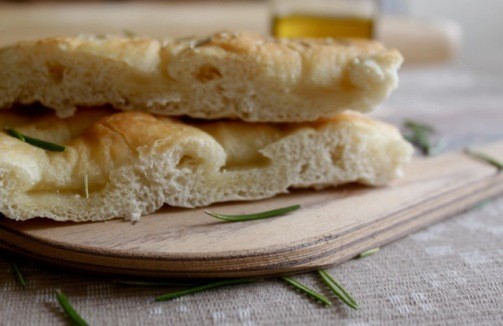Focaccia (pronunced foe-CA-cha) is a soft, flat oven-baked Italian bread, so popular that most people could very well have had their first taste of it in an Italian bakery or restaurant somewhere other than on Italian soil. It is made of simple ingredients such as flour, yeast, water, olive oil and salt. It is seasoned with olive oil and herbs and is often topped with different vegetables (tomatoes, onions, potatoes, eggplants, zucchini or whatever else you like), cheese or meat. It’s something enjoyable any time of the day as an appetizer, a sandwich bread, with a meal instead of traditional bread, or even “come rompi digiuno” – as a snack (this is a common kids’ snack to take to school; they love it!!!). Focaccia traces its origins to the ancient Roman pan focacious, a flat bread baked on the hearth. In Latin, in fact, focus means hearth, a place for baking. Nowadays focaccia is widely spread all over the country, and it seems that each region has its own focaccia recipe. The most common and wide-spread ones are focaccia Ligure (from Ligury) and focaccia Pugliese (from the region of Puglia). Focaccia Genovese from the city of Genoa is very simple, prepared with only salt and oil olive on top, but the flavorful and fruity olive oil from this region adds a unique taste to the bread dough and makes this ancient food one of the most appreciated snacks. The Genovesi (people from Genoa) are very proud of their focaccia, and they even enjoy it for breakfast soaked in cappuccino or latte macchiato. Not too far away, focaccia di Recco (near Genoa) is richer version with a cheese filling between two thin layers of dough, making it a nice choice for a light lunch. Focaccia Pugliese is usually prepared with vegetables on top such as fresh tomatoes and olives, finely sliced potatoes or other vegetables such as onions. You might have also tried Focaccia dolce (sweet focaccia), popular in some Northern regions, made simply from regular sweet focaccia dough sprinkled with sugar, raisins, honey and almonds.
FOCACCIA
Preparation time: 2 ½ hours Baking time: 15 minutes Servings: 6-8
INGREDIENTS
Basic recipe
500 g (3 1/2 cups) high-gluten flour (Manitoba)
320 ml water (1 cup + 3 tablespoons) at 38°C, 100 °F
130 ml (9 tablespoons) olive oil (Extra Virgin)
10 g (2 teaspoons) salt
1 teaspoon sugar
1 package (7 g ;1 heaping teaspoon) dried yeast or 1 cube (25 g; about 1 ounce) fresh yeast
Coarse salt
Topping
Focaccia with rosemary/oregano
The leaves only from 2 fresh rosemary sprigs or 2 tablespoon dried oregano
Focaccia with olives
150 g (1 cups) green olives
DIRECTIONS
1. In a small pitcher dissolve the sugar in warm water, then add 40 ml (3 tablespoons) olive oil. Add the yeast and mix. Sugar is the so called “nourishment” for yeast
2. Pour the liquid in a large glass bowl and combine with half of the flour. Stir well until you have a smooth batter
3. Add the salt to the batter stirring well. Remember never add yeast directly to salt because it will prevent the yeast from rising
4. Add the remaining flour and oli to the batter. Mix well until you have a smooth and even dough, but still a little bit sticky
5. Remove the dough from the bowl and turn it out onto a lightly floured surface; knead briefly for about 1-2 minutes. Do not add too much flour otherwise the dough will get tough
6. Lightly oil (with about 3 tablespoons) a 25×35 cm (10×14 in.) baking sheet; place the dough in center of the pan and cover with a cotton towel. Let rise in a warm, draft-free place (about 25°C, 77°F) for about 60-90 minutes until doubled in size
7. Preheat oven to 220 °C (425°F)
8. Pat the dough into the baking sheet, filling it completely. Brush the dough with oil and sprinkle with some coarse salt. Let it rise for about 30 minutes at 25°C (77°F) until increases its volume
9. Press some deep holes into the dough with your finger tips, covering the entire surface
10. Drizzle with about 3 tablespoons oil olive (cover all areas of the dough) and wet the top with some water, using a spray-bottle, to keep focaccia soft. Add your favorite topping
11.Bake for 15-20 minutes
12. Remove from oven and cool on a grid.
Note: You can add two tablespoons of semolina to the flour, this will makes the crust crunchier. The type of water is very important; the pH should be around 6. I usually use bottled drinking water to avoid having too much chlorine in the dough. The rising temperature is critical too, therefore place the dough in a warm draft-free place and do not open the oven during baking. Another important information is to never mix salt and yeast directly, because salt inhibits the action of the yeast. Focaccia can keep for about two days wrapped in plastic wrap, but I suggest eating it fresh, just out of the oven, to fully enjoy its fragrance. -Paola


I adore focaccia! In fact it is a recent obsession! It’s just so versatile and delicious!
Thanks Nkem! You are right, focaccia is really versatile…you can use so many topping! I love it with onions too. Happy cooking 🙂